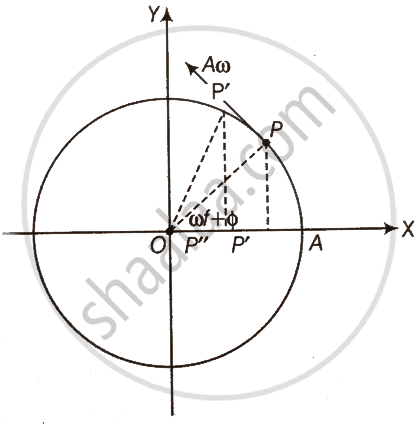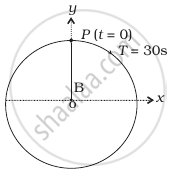Advertisements
Advertisements
Question
In figure, what will be the sign of the velocity of the point P′, which is the projection of the velocity of the reference particle P . P is moving in a circle of radius R in anticlockwise direction.

Solution
As the particle on reference circle moves in the anti-clockwise direction. The projection will move from P’ to O towards the left.

Hence, in the position shown the velocity is directed from P' → P" i.e., from right to left, hence sign is negative.
APPEARS IN
RELATED QUESTIONS
Figures correspond to two circular motions. The radius of the circle, the period of revolution, the initial position, and the sense of revolution (i.e. clockwise or anti-clockwise) are indicated on each figure

Obtain the corresponding simple harmonic motions of the x-projection of the radius vector of the revolving particle P, in each case.
Figure (a) shows a spring of force constant k clamped rigidly at one end and a mass m attached to its free end. A force F applied at the free end stretches the spring. Figure (b) shows the same spring with both ends free and attached to a mass mat either end. Each end of the spring in Fig. (b) is stretched by the same force F.

(a) What is the maximum extension of the spring in the two cases?
(b) If the mass in Fig. (a) and the two masses in Fig. (b) are released, what is the period of oscillation in each case?
Which of the following functions of time represent (a) simple harmonic, (b) periodic but not simple harmonic, and (c) non-periodic motion? Give period for each case of periodic motion (ω is any positive constant):
sin ωt – cos ωt
Which of the following functions of time represent (a) simple harmonic, (b) periodic but not simple harmonic, and (c) non-periodic motion? Give period for each case of periodic motion (ω is any positive constant):
3 cos `(π/4 – 2ω"t")`
Which of the following functions of time represent (a) simple harmonic, (b) periodic but not simple harmonic, and (c) non-periodic motion? Give period for each case of periodic motion (ω is any positive constant):
exp (–ω2t2)
Which of the following functions of time represent (a) simple harmonic, (b) periodic but not simple harmonic, and (c) non-periodic motion? Give period for each case of periodic motion (ω is any positive constant):
1 + ωt + ω2t2
A particle is acted simultaneously by mutually perpendicular simple harmonic motions x = a cos ωt and y = a sin ωt. The trajectory of motion of the particle will be ______.
Figure shows the circular motion of a particle. The radius of the circle, the period, sense of revolution and the initial position are indicated on the figure. The simple harmonic motion of the x-projection of the radius vector of the rotating particle P is ______.

The rotation of earth about its axis is ______.
- periodic motion.
- simple harmonic motion.
- periodic but not simple harmonic motion.
- non-periodic motion.
A particle is in linear simple harmonic motion between two points A and B, 10 cm apart (Figure). Take the direction from A to B as the + ve direction and choose the correct statements.

- The sign of velocity, acceleration and force on the particle when it is 3 cm away from A going towards B are positive.
- The sign of velocity of the particle at C going towards O is negative.
- The sign of velocity, acceleration and force on the particle when it is 4 cm away from B going towards A are negative.
- The sign of acceleration and force on the particle when it is at point B is negative.
